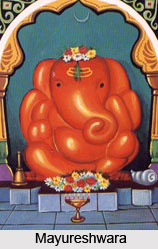 The legend of Mayureshwara and Vinata is mentioned in the Ganesha Purana. The tale describes about the birth of the vahana or mount of Lord Mayuresvara. The legend states that once Mayureshwara and his friends were playing in a mango grove in the forest. The children eventually became hungry and asked Ganesha to allow them to eat the mango. After the deity gave His consent, the children started eating the mango. They started playing with the fruits and threw mango at each other. One of the mangoes hit the head of a woman who was protecting an egg. She became angry and tried to catch Mayureshwara. Thus the noble child hid himself inside the hole of a tree. There He found a huge egg which broke as soon as he touched it. A chick came out from the egg and started moving its wings. Mayureshwara rushed out of the tree and caught the chick which transformed into a huge peacock. Lord Ganesha attacked the bird as He thought that it would kill him and the sons of the sages.
The legend of Mayureshwara and Vinata is mentioned in the Ganesha Purana. The tale describes about the birth of the vahana or mount of Lord Mayuresvara. The legend states that once Mayureshwara and his friends were playing in a mango grove in the forest. The children eventually became hungry and asked Ganesha to allow them to eat the mango. After the deity gave His consent, the children started eating the mango. They started playing with the fruits and threw mango at each other. One of the mangoes hit the head of a woman who was protecting an egg. She became angry and tried to catch Mayureshwara. Thus the noble child hid himself inside the hole of a tree. There He found a huge egg which broke as soon as he touched it. A chick came out from the egg and started moving its wings. Mayureshwara rushed out of the tree and caught the chick which transformed into a huge peacock. Lord Ganesha attacked the bird as He thought that it would kill him and the sons of the sages.
The bird fell on the ground and child Ganesha released it from the bondage. The noble child subdued the bird and mounted over it. Then the woman prayed to Lord Ganesha and announced that she was Vinata, the consort of Sage Kashyapa. The peacock was the son of Kashyapa. The woman offered the bird to the Lord as His vahana. Thus the peacock served as the mount of Lord Ganesha and He was named Mayureshwara.
This article is a stub. You may enrich it by adding more information to it. You can send your write-up at content@indianetzone.com




















